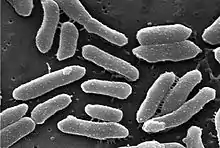Morganellaceae
The Morganellaceae are a family of Gram-negative bacteria that include some important human pathogens formerly classified as Enterobacteriaceae. This family is a member of the order Enterobacterales in the class Gammaproteobacteria of the phylum Proteobacteria. Genera in this family include the type genus Morganella, along with Arsenophonus, Cosenzaea, Moellerella, Photorhabdus, Proteus, Providencia and Xenorhabdus.[1]
| Morganellaceae | |
|---|---|
 | |
| Providencia alcalifaciens | |
| Scientific classification | |
| Domain: | |
| Phylum: | |
| Class: | |
| Order: | |
| Family: | Morganellaceae Adeolu et al., 2016 |
| Genera | |
|
Arsenophonus | |
Human pathogens
A number of Morganellaceae bacterial species are opportunistic human pathogens, including Proteus, Providencia, and occasionally Morganella in nosocomial settings.
Proteus
Three Proteus species P. vulgaris, P. mirabilis, and P. penneri are opportunistic human pathogens, most commonly resulting in urinary tract infections.[2] Proteus vulgaris is commonly found in the intestine in various animals, and is shed into manure and soil.
About 10–15% of kidney stones are struvite stones, caused by alkalinization of the urine by the action of the urease enzyme of Proteus (and other) bacterial species.[3]
Providencia
Providencia rettgeri is a common cause of traveller's diarrhea.[4]
Insect pathogens and symbionts
A number of Morganellaceae have intimate relationships with insects and other invertebrates.
Arsenophonus
Arsenophonus are endosymbiotic bacteria of various insects. In Nasonia parasitic wasps, Arsenophonus nasoniae acts as a reproductive manipulator by killing developing male wasps. This promotes an increased frequency of females in the population, which are the only biological sex that transmits Arsenophonus to the next generation. This type of interaction is referred to as "male-killing or son-killing."[5]
In flies and Lice, Arsenophonus-like bacteria act as primary symbionts faithfully transmitted from generation to generation.[5] In such relationships, the primary endosymbiont commonly supplements the host's metabolism by providing essential vitamins and nutrients that the host cannot synthesize itself.[6]
Photorhabdus and Xenorhabdus
Photorhabdus and Xenorhabdus are bacterial associates of entomopathogenic nematodes. These nematodes infect insects and regurgitate their Photorhabdus or Xenorhabdus bacteria into the insect blood (also called hemolymph). The bacteria then suppress the insect's immune response, increasing the success of the nematode parasite. As a result of this highly effective evolutionary strategy, entomopathogenic nematodes are commonly used as biological control agents against insect pests like corn rootworms.[7]
Providencia
Providencia are common bacterial species in the microbiome of Drosophila fruit flies.[8] In Drosophila melanogaster, Providencia rettgeri is a common pathogen isolated from wild-caught flies.[9] The fly immune system defends against this infection using a highly specific antimicrobial peptide that is required for defence against P. rettgeri, but not other Providencia species.[9][10]
References
- Adeolu, Mobolaji; Alnajar, Seema; Naushad, Sohail; S Gupta, Radhey (2016). "Genome-based phylogeny and taxonomy of the 'Enterobacteriales': proposal for Enterobacterales ord. nov. divided into the families Enterobacteriaceae, Erwiniaceae fam. nov., Pectobacteriaceae fam. nov., Yersiniaceae fam. nov., Hafniaceae fam. nov., Morganellaceae fam. nov., and Budviciaceae fam. nov". International Journal of Systematic and Evolutionary Microbiology. 66 (12): 5575–5599. doi:10.1099/ijsem.0.001485. ISSN 1466-5026. PMID 27620848.
- Guentzel MN (1996). Baron S; et al. (eds.). Escherichia, Klebsiella, Enterobacter, Serratia, Citrobacter, and Proteus. In: Barron's Medical Microbiology (4th ed.). Univ of Texas Medical Branch. ISBN 978-0-9631172-1-2. (via NCBI Bookshelf).
- Armbruster, Chelsea; Mobley, Harry; Pearson, Melanie (2018). "Pathogenesis of Proteus mirabilis Infection". EcoSal Plus. 8 (1). doi:10.1128/ecosalplus.ESP-0009-2017. PMC 5880328. PMID 29424333.
- Yoh, M; Matsuyama, J; Ohnishi, M; Takagi, K; Miyagi, H; Mori, K; Park, KS; Ono, T; Honda, T (2005). "Importance of Providencia species as a major cause of travellers' diarrhoea". J Med Microbiol. 54 (11): 1077–82. doi:10.1099/jmm.0.45846-0. PMID 16192440.
- Nováková, Eva; Hypša, Václav; Moran, Nancy A (2009). "Arsenophonus, an emerging clade of intracellular symbionts with a broad host distribution". BMC Microbiology. 9 (1): 143. doi:10.1186/1471-2180-9-143. PMC 2724383. PMID 19619300.
- Rockwell, Nathan C.; Lagarias, J. C.; Bhattacharya, Debashish (17 October 2014). "Primary endosymbiosis and the evolution of light and oxygen sensing in photosynthetic eukaryotes". Frontiers in Ecology and Evolution. 2 (66). doi:10.3389/fevo.2014.00066. PMC 4343542. PMID 25729749.
- Jaffuel, Geoffrey; Imperiali, Nicola; Shelby, Kent; Campos-Herrera, Raquel; Geisert, Ryan; Maurhofer, Monika; Loper, Joyce; Keel, Christoph; Turlings, Ted C. J.; Hibbard, Bruce E. (28 February 2019). "Protecting maize from rootworm damage with the combined application of arbuscular mycorrhizal fungi, Pseudomonas bacteria and entomopathogenic nematodes". Scientific Reports. 9 (1): 3127. Bibcode:2019NatSR...9.3127J. doi:10.1038/s41598-019-39753-7. PMC 6395644. PMID 30816250.
- Martinson, VG; Douglas, AE; Jaenike, J (2017). "Community structure of the gut microbiota in sympatric species of wild Drosophila". Ecology Letters. 20 (5): 629–639. doi:10.1111/ele.12761. PMID 28371064.
- Unckless RL, Howick VM, Lazzaro BP (January 2016). "Convergent Balancing Selection on an Antimicrobial Peptide in Drosophila". Current Biology. 26 (2): 257–262. doi:10.1016/j.cub.2015.11.063. PMC 4729654. PMID 26776733.
- Hanson MA, Dostálová A, Ceroni C, Poidevin M, Kondo S, Lemaitre B (February 2019). "Synergy and remarkable specificity of antimicrobial peptides in vivo using a systematic knockout approach". eLife. 8. doi:10.7554/eLife.44341. PMC 6398976. PMID 30803481.